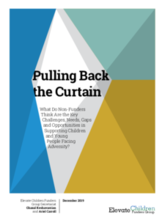Introduction
One of Elevate Children Funders Group’s (ECFG) overarching goals is to map emerging trends, gaps and opportunities across the children and youth in adversity field. To this end, the ECFG Secretariat recently undertook an exercise and asked non-funders for their input. It is a rare opportunity for non-funders to honestly and anonymously share with funders their candid feedback of what is working and not working. By sharing and learning together, we can both deepen our knowledge and ensure better outcomes for children and young people the world over.
In July-August 2019, the ECFG Secretariat shared a six-question survey with over 70 non-funder stakeholders representing academia, think tanks, networks, UN agencies, international non-governmental organizations (NGOs), community-based organizations, human rights organizations and youth-led organizations around the world. These stakeholders work in the field of violence prevention, child protection, children’s care, early childhood development, mental health, youth empowerment, child and youth rights, and education. ECFG received responses from 30 stakeholders, representing: international NGOs (67.9%); networks (14.3%); academia or think tanks (10.7%); and national NGOs (7.1%). Forty-two percent are based in North America, thirty-six percent in Europe and the United Kingdom, one representative in Latin America; and three representatives in South and Southeast Asia. All responses were in English, except for one (Spanish).
This report is an analysis of the feedback that we received to the following six questions:
- What do you expect to be the most pressing challenge that you and your partners will face in the coming years?
- What have been the major successes the last few years in supporting and protecting children and youth facing adversity globally?
- What are the major challenges and needs for children and youth facing adversity globally?
- What issue (specific to children and youth facing adversity) do you think will become more important in the coming years?
- What have been the major gaps in funding for children and youth facing adversity?
- What can foundations do more effectively in supporting you and your partners to carry out your work?
We recognize that this was a simplistic exercise and not a deep analysis. In the future, it is recommended that ECFG expand this analysis over a six-month period by conducting in-depth interviews, virtual and in-person focus group discussions and meet with organizations and youth/child activists working at country and community levels. As an attempt to pull back the curtain and break down barriers between funders and the non-funder community, we nonetheless hope that this report provides ECFG members and partners with a better understanding of the challenges and needs of implementing organizations and most importantly, of children and young people.

